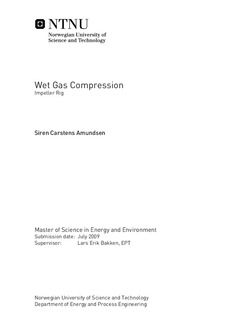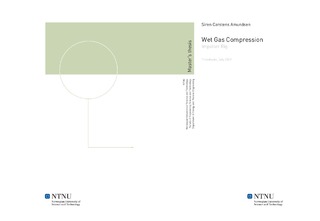| dc.contributor.advisor | Bakken, Lars Erik | nb_NO |
| dc.contributor.author | Amundsen, Siren Carstens | nb_NO |
| dc.date.accessioned | 2014-12-19T11:44:35Z | |
| dc.date.available | 2014-12-19T11:44:35Z | |
| dc.date.created | 2010-09-04 | nb_NO |
| dc.date.issued | 2009 | nb_NO |
| dc.identifier | 348903 | nb_NO |
| dc.identifier | ntnudaim:4856 | nb_NO |
| dc.identifier.uri | http://hdl.handle.net/11250/233680 | |
| dc.description.abstract | Wet gas compression technology is of great value to the oil and gas industry for boosting of unprocessed well stream and to reduce investment costs related to equipment and personnel. The growing interest in wet gas compression leads to a general request for accurate performance calculation procedures and proper measurement techniques for multiphase flow metering in compressors. An impeller rig for examination of single-phase and multiphase performance and aerodynamic stability is under construction at the test facility at NTNU. The construction of the compressor rig is behind time due to late deliveries of the compressor components and instrumentation. The performance calculations are therefore based upon one compressor test conducted with dry gas at part-load. The thermodynamic equation of state for ambient air is verified to be consistent with the ideal gas law in the compressor pressure and temperature range. The calculated polytropic performance is calculated with ideal gas assumptions and compared to values estimated by PRO/II. By analyzing the results the sensitivity of the calculation procedures is identified and the suitability for the ideal polytropic performance calculations is validated for the actual compressor test and operating range. A sensitivity analysis is conducted in order to determine the effect of measurement uncertainties on performance calculations. Due to the low pressures involved for the compressor test, the performance calculation procedures are highly sensitive to uncertainties in the pressure measurements. Uncertainties in the temperature measurements will only slightly influence the polytropic head, but have great influence on the polytropic efficiency. The efficiency and operating range of a compressor are constrained by aerodynamic instabilities. This thesis describes the different flow phenomena associated with compressor instability and presents recommendations for suitable instrumentation and measuring techniques. Various visualization techniques are in addition evaluated to determine the suitability for multiphase compressors. Dynamic pressure transducers installed in the inlet and discharge piping are recommended for detection of pressure pulsation throughout the compressor system. Unsteady internal pressure measurements can be obtained from circumferentially distributed pressure transducers at various locations within the compressor components. Vibration probes installed at each end of the rotor are recommended for the vibration measurements. By analyzing the frequency spectrum for the pressure fluctuation and radial vibrations one can identify the type of instability phenomenon that occur. Laser measurement techniques are recommended for the flow visualization in order to obtain information on the main features of the multiphase flow field. | nb_NO |
| dc.language | eng | nb_NO |
| dc.publisher | Institutt for energi- og prosessteknikk | nb_NO |
| dc.subject | ntnudaim | no_NO |
| dc.subject | SIE5 energi og miljø | no_NO |
| dc.subject | Varme- og energiprosesser | no_NO |
| dc.title | Wet Gas Compression: Impeller Rig | nb_NO |
| dc.type | Master thesis | nb_NO |
| dc.source.pagenumber | 118 | nb_NO |
| dc.contributor.department | Norges teknisk-naturvitenskapelige universitet, Fakultet for ingeniørvitenskap og teknologi, Institutt for energi- og prosessteknikk | nb_NO |

